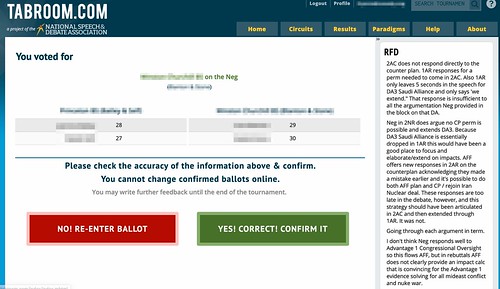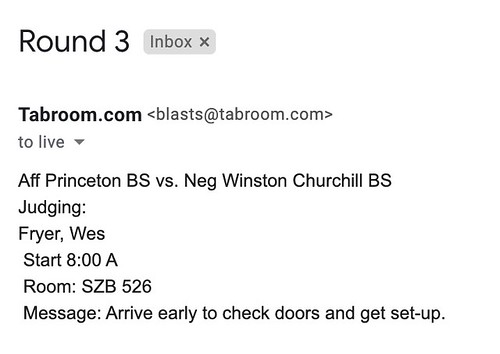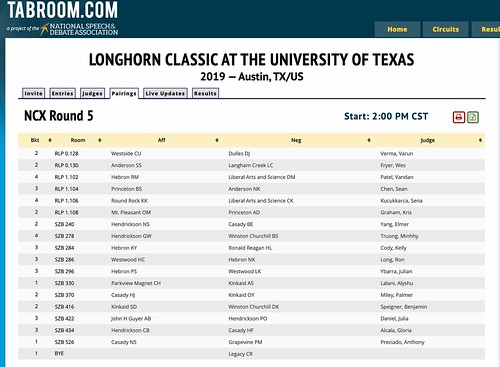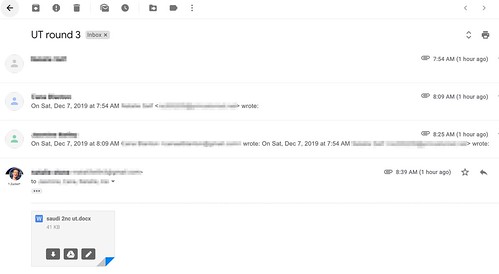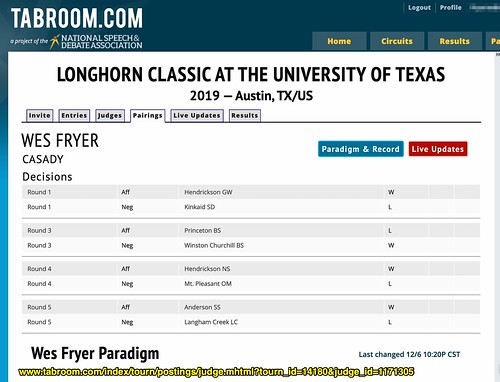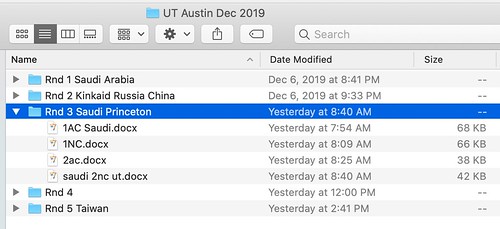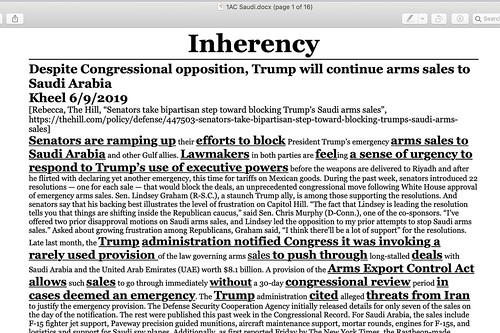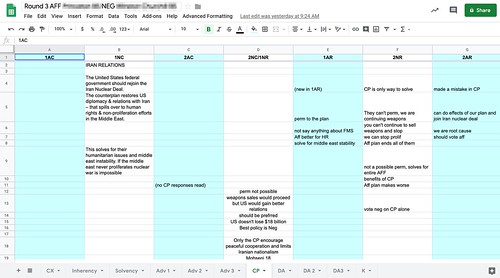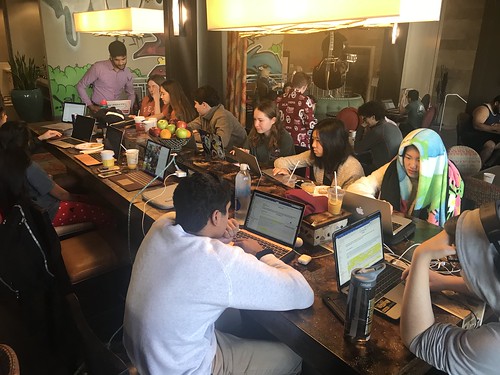What Paperless Debate Can Teach Us About the Classroom of the Future
Author: Wesley Fryer
Go to Source
This weekend I had the privilege and opportunity to fully experience “paperless debate” at the UT Austin Longhorn Classic Debate Tournament, as an adult chaperone for our high school debate team at Casady School. In this post, I’d like to reflect on what these experiences suggest, reveal and invite when it comes to student learning, teaching, and “the classroom of the future.”
I judged five novice cross-examination debate rounds on Friday afternoon / evening and Saturday at the tournament. This was my first time to judge at a tournament using TabRoom.com, a fantastic website and project by the National Speech and Debate Association (formerly “the other” NFL, or National Forensics League.) The website allows both competing students and judges to receive text message and/or email alerts about upcoming rounds and also provides live/archived postings for all tournament rounds and outround brackets.
This digital access on a smartphone, laptop or tablet computer is wonderful and helpful, but not necessarily transformative. In my analogy between paperless debate and classroom teaching and learning, this like having access to the information of the Internet’s World-Wide Web. It’s powerful, it makes things much more convenient, but by itself it doesn’t TRANSFORM an experience for anyone. Instead of waiting for paper pairings to be posted physically on a wall, and having to go look at that piece of paper, everyone at this debate tournament can view the details and location for their next assigned round on their own Internet-connected device. This saves time and energy, but it doesn’t transform interactions or conversations.
Here’s what CAN and SHOULD transform conversations at a (largely) paperless debate tournament like the Longhorn Classic this weekend.* Paperless debate means all prepared speeches (like the first 1AC or “first affirmative constructive” speech) are exchanged electronically between the teams and the judge. In all the rounds I judged in Austin this weekend, this meant we used an “email chain” to share evidence and speech files. The first speaker collected everyone’s email address in the round before 1AC, usually handing their laptop to each person to type their email address. They attached their speech file (a MS Word .docx file in all cases) and sent it before their speech. When I’ve seen recent debate rounds back in Oklahoma, teams exchanged USB flash drives with each other and the judge to provide this file exchange. However, the “email chain” method was much more efficient. This time to exchange files is NOT counted against any team’s prep time. It was MUCH faster to use an “email chain” for this file transfer, but it requires (of course) reliable and fast WiFi at the hosting school for the debate tournament. That is not always a given today at many public high schools. Fortunately it IS at most colleges and universities today in classrooms where debate rounds are held.
Here’s where things with paperless debate become TRANSFORMATIVE for me this weekend. The TabRoom.com website allows each judge to share their judging and debate “paradigm” and philosophy, so teams can access and read it prior to each debate. This is mine from UT Austin this weekend. This means each debator, if s/he chooses, can get some helpful and in-depth insight prior to the round about each judge’s experiences, predispositions with different kinds of arguments, and biases. This not only saves time prior to the round, when in the past competitors would ask a judge to share their paradigm out loud, it also allows competitors to ASK QUESTIONS for clarifications by each judge if desired. This is like a “flipped classroom lesson,” when students watch a video BEFORE class to get information / instruction, and then come to class to INTERACT with the teacher / instructor / professor and in many cases work problems, do lab work, and other kinds of INTERACTIVE and SOCIAL activities which cannot be done alone / in isolation / at home away from the classroom. This maximizes the potential value of face-to-face (F2F) instructional time among students and with their teacher / instructor, something Jose Bowen (@josebowen) championed in his 2012 book, “Teaching Naked: How Moving Technology Out of Your College Classroom Will Improve Student Learning.” (Bowen, like me, is not anti-technology, but he IS against “PowerPointing your students to death,” especially in a college environment where they are literally paying $$$ for what should be a high quality, interactive and transformative learning experience.)
The transformative nature of “paperless debate” does not stop there. By using an “email chain” or “flashing evidence” (sharing) prior to each speech, as a judge I had full access to each speaker’s taglines and evidence, for most constructive speech (initial) argumentation in the round.
This screenshot is an example of a 1AC speech, with the taglines and words from evidence / cards read by debators BOLDED and often in ALL CAPS.
Full digital access to all constructive speech evidence was VERY TRANSFORMATIVE for me as a debate judge. This means I could copy and paste taglines very quickly and accurately into my Google Sheets CX debate round template, leaving a space between arguments. Instead of focusing and STRUGGLING to capture the gist of each debator’s separate argument, along with the author’s last name and the year their study or article was published, I USED COPY / PASTE. This allowed me to LISTEN more carefully to each piece of evidence as it was read, and simultaneously ANALYZE that evidence to fit it into the line of argumentation being presented and the overall round. THIS was the most transformative element of my experiences this weekend with “paperless debate,” and is the most important thing which “speaks to me today” about how our teaching and student learning in the digitally connected classroom of the twenty-first century CAN and SHOULD change.
A few years ago, family friend Ken Brooks, who is a professor of Landscape Architecture at Arizona State University, shared his philosophy with me of providing students with his PowerPoint files BEFORE each class lecture. He said many professors today are opposed to this, because their conception of CLASSROOM LEARNING involves students CAPTURING LECTURE NOTES which are delivered orally. That is exactly “the old paradigm” of analog/paper-based cross examination debate: We would listen to a speaker read and talk (often as fast as they possibly could) and then furiously try to scribble down shorthand notes of their main ideas and sources. I’m with Ken Brooks on this: We need to give our students (as well as debate opponents in CX debate) FULL COPIES of our presentation files / resources or case files / debate evidence in advance of our oral delivery. Why? Because as Ken Brooks explained to me years ago, this allows student to focus on IDEAS and ANALYSIS more than TEXT CAPTURE. This is transformative, and can lead to better thinking, debate, and overall experiences for everyone in the room, whether we’re talking about a classroom lesson or a cross-examination debate.
Exchanging evidence before a debate speech flies in the face of some historic strategies of CX debate. In the past, and to a lesser degree today, some teams will try and run an uncommon affirmative case (we used to call these “squirrel cases,” and the word “squirrel” evidently now has a context in parliamentary debate.) Part of that strategy “back in the day” was that the negative / opposing debate team wouldn’t know what arguments they had to analyze and confront in a round until the 1AC speaker (first affirmative) opened their mouth.
While “squirrel affirmative cases” may still be around and that strategy favored by some debaters, in general it seems that many debate teams today choose to run a primary case for all the teams at their school, and freely share evidence and strategies among all debaters. In practice then, this can make debates much more about argumentation, organization, delivery, and analysis. I think this shift in skill focus is WONDERFUL, and as I’m arguing overall in this post, TRANSFORMATIVE in ways which are beneficial for learning.
Here’s a final thought and photograph to close this piece. Here’s a photo of some of our Casady debate team members on Friday morning before the tournament rounds started.
I want you to notice several things.
- Everyone has their own laptop computer, connected to WiFi and also running the latest version of MS Office. (Office is the de-facto standard / requirement for CX debate file exchange.)
- Many students are working independently, but some students (as well as our debate coach) are interacting with each other and coaching / teaching on different topics.
- The students are gathered around a bar area which has plenty of electrical outlets, and is ideal for collaboration / working together. It’s a great collaboration space.
This is a excellent picture of interactive learning, which is very different than traditional classroom learning which emphasized (almost exclusively) individual, solo effort. Instead of becoming “distanced and distracted” from each other, as futurist John Naisbitt feared in 1999, our networked, digital technology tools and information superhighway offer us opportunities to be MORE CONNECTED AND INTERACTIVE than ever before. This outcome is the result of deliberate, pedagogical choices, however.
These are important lessons to learn from “paperless debate” and choices to make, for life and learning. We each have opportunities to use technologies in our pockets in transformative ways. Access is an important ingredient and pre-requisite, but choices are essential as well.
If you enjoyed this post and found it useful, consider subscribing to Wes’ free, weekly newsletter. Generally Wes shares a new edition on Monday mornings, and it includes a TIP, a TOOL, a TEXT (article to read) and a TUTORIAL video. You can also check out past editions of Wes’ newsletter online free!
Did you know Wes has published several eBooks and “eBook singles?” 1 of them is available free! Check them out! Also visit Wes’ subscription-based tutorial VIDEO library supporting technology integrating teachers worldwide!
MORE WAYS TO LEARN WITH WES: Do you use a smartphone or tablet? Subscribe to Wes’ free magazine “iReading” on Flipboard! Follow Dr. Wesley Fryer on Twitter (@wfryer), Facebook and Google+. Also “like” Wes’ Facebook page for “Speed of Creativity Learning“. Don’t miss Wesley’s latest technology integration project, “Show With Media: What Do You Want to CREATE Today?“

